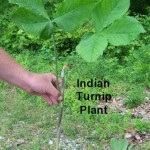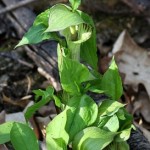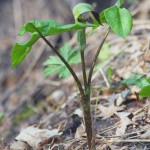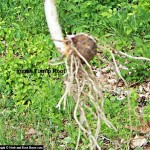Indian Turnip – Arisaema triphyllum
|
Current Demand = Normal |
Parts Used: Root |
 |
 |
 |
 |
Family: Araceae
Common Names: Jack-in-the-Pulpit, bog onion, brown dragon, Indian turnip, dragon-root, wake-robin or wild turnip
Description:
Indian turnip root is a perennial herbaceous plant that is fairly common. It can grow up to 20-26 inches in height. There are 3 large leaves that grow together at the top of the stem. Each leaf is then divided into three parts that are smooth and veined. They often hides the flower. The flowers are greenish yellow with brown or purple stripes and bloom in the spring.
The flower has a “spathe referred to as the pulpit for this flower, and contains a “spadix” (Jack) covered with tiny flowers that are of both sexes. In the fall there are bright red shiny berries which replace the flower.
Growing region: The plant can be found in the wild from the east coast to Texas and north to Minnesota. It can be cultivated in almost any area in the U.S. It can be found near waterfalls, running streams and other areas rich in water.
Harvesting/drying:
Harvest the root in the fall. The tubers may need to be sliced to aid in drying. After harvest, remove all foreign matter (rocks, weeds and other roots) and spread in a thin layer immediately. When possible dry indoors in a well ventilated barn loft or attic to protect from the elements. If natural heat is not available you may need to add heat and a fan for continuous airflow. Whether you dry indoors or outdoors you will need to turn or stir the roots daily.
The key to drying any root, herb or bark is an even combination of heat and airflow. Never dry in an oven or microwave. Indian tuber be completely dry (largest stem will snap not bend) in 3-7 days depending on the drying conditions. Once it is dried place the turnips carefully into a cardboard box or paper bag for storage in a dry area until you are ready to sell or use. Never store the tubers/roots in plastic or it can mold.
Cultivation
Indian turnip root prefers mildly acidic, neutral, mildly alkaline rich soil where there is partial shade and the soil is well drained. It needs average water but does not do well if over watered. It can be found in woodlands and wildflower gardens.
Propagation
Seed: Can be directly sowed outdoors in the fall with just a light covering over the seeds. The seeds can be sown indoors using a cold frame or unheated greenhouse. Prick the plants when large enough and place in individual pots until ready to plant in the summer into permanent homes. If you plan to harvest your own seeds, allow the pods to dry on the plant. Break them open and collect the seeds. Wear protective gloves when handling the seeds and remove the coating on the seeds before you store them. These seeds do not store well and need to be used as soon as possible.
Division: Divide the rhizomes in the fall into sections that include offsets. Replant immediately into a permanent home.
Attributes (Images)
By IvoShandor (Own work) [GFDL, CC-BY-SA-3.0 or CC BY 2.5], via Wikimedia Commons
 Root Buyer
Root Buyer